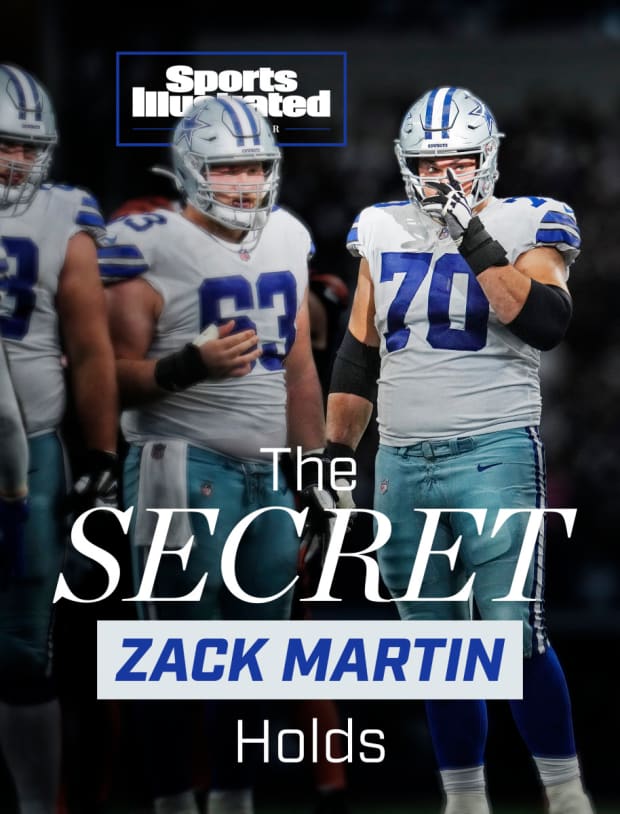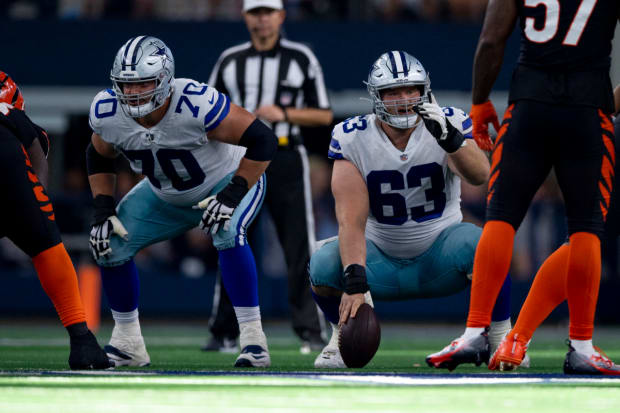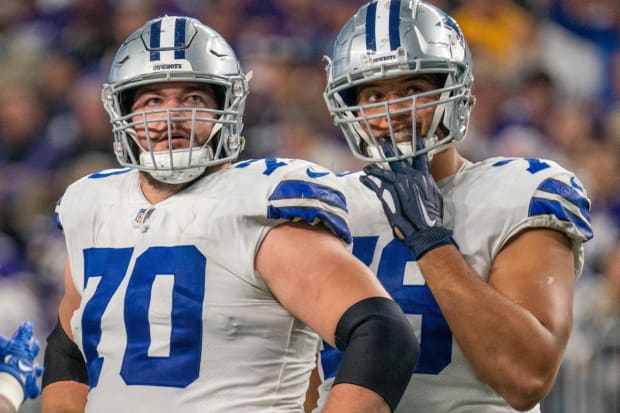A certain statistic circumnavigated the football world late this summer, soaring above the usual wave of colorless preseason content. It first took flight on social media—raising eyebrows, halting scrolling thumbs, all those early signs of something going gobsmacking viral. And before long it barged into real life, too, popping up one day in conversation at its point of origin inside the Cowboys’ offensive line room.
“My first reaction was like, Damn,” center Tyler Biadasz says.
“Just incredible,” tackle Terence Steele says.
“Oh, yeah, I’ve become very familiar with it through the Twitterverse, through the building,” tackle Tyler Smith says. “It’s pretty absurd.”
The stat is simple enough, requiring no knowledge of QBR, PFF or any such acronymic mode of analysis. Yet, like a picture, it’s worth a thousand words about its subject (or, in this article’s case, exactly 2,927). In its original form, as Cowboys right guard Zack Martin prepared for his ninth NFL year, it went like this:
Martin has reached more Pro Bowls (seven) than he has received career holding penalties (six).

Cooper Neill/Getty Images
From sports bars to message boards, it’s a well-worn cliché that holding could be called on every NFL snap. And while this isn’t actually true—at least not according to the letter of the law—even the most reputable blockers occasionally find themselves busted for an illicit clutch, grab, rip, tug or hug, and then forced to endure the public-shaming ritual of having their number announced over the entire stadium loudspeakers while a close-up shot of their guilty face flashes on television.
Last year alone, 26 offensive linemen finished with at least four accepted holds, among them Browns guard Wyatt Teller and Niners tackle Trent Williams, both universally recognized as being among the league’s elite. By contrast, entering ’22, Martin boasted just one holding penalty on his record—not counting another that was declined—since the start of the ‘17 season, a span of more than 5,300 offensive and special teams snaps including the playoffs. (During that time he also made four Pro Bowls, most recently last year alongside Teller and Williams).
So how is such a pristine rap sheet possible? Sitting down at the Cowboys’ facility after a recent practice, Martin confesses his secrets. “I’d be a liar if I told you I don’t hold,” he says. “But the biggest thing is understanding when I can and when I can’t.”
Growing up in Indianapolis, Martin, 32, initially saw himself pursuing the pass-rushing path of his father, Keith, a defensive tackle for the University of Kentucky from 1980 to ’83. But while teenage Zack lined up on both sides of the ball through high school, the only recruiting interest he drew from college programs was as a blocker. “Less by choice,” he says now. “I was better at D-line when I was younger. Then I got older, got a little bigger, [and] my athleticism didn’t quite [catch up].”
Even during his first two seasons as Notre Dame’s starting left tackle, Martin says, “I just looked at O-line as the position I played.” But that changed before his redshirt junior year, 2012, with the arrival of veteran positional coach Harry Hiestand, whose teachings instilled in Martin a new sense of appreciation for the collectiveness required of their craft. “He really harped on how the position as a whole is unique, because it’s the only one that has five guys on the field at all times,” he says. “That’s what’s so cool about playing offensive line: One guy is not going to make the play. It’s five guys together—doing the right thing, doing their job, communicating—that makes things go.”

Jerome Miron/USA TODAY Sports
Of course, as any lineman knows, one guy is plenty capable of making things stop … or worse. “I take pride in not being a guy that hurts the offense going backwards,” Martin says. And really, what is more shameful than an ill-timed hold that negates a big gain? “No one wants a false start, but it’s five yards,” Martin says. “On holds, not only are you going 10 yards back, but you got to subtract that play that you just did. A lot of times it’s a drive-killer.”
Beyond the team-first mentality required to maintain a hold-free existence, Martin starts with his individual fundamentals. “You want to have your hands inside; that’s step one,” he says. “If you’re controlling the [opponent’s] breastplate, up underneath their pads, a lot of times you’re not gonna get called.”
Step two involves what the 6'4", 315-pound Martin describes as “driving my backside knee,” a blocking style that he and his Cowboys teammates “work [on] a ton,” he says. “If you stop your feet and you’re just trying to muscle the guy, that’s when he gets extended and starts throwing you, and the holds come in. But if your feet are constantly moving, he’s trying to fight off your pressure, too, so he can’t just worry about where the ball is.” This is especially critical for an average-sized guard like Martin. “My game is not, let me wrestle this 320-pound defensive tackle,” he says. “I just can’t do it. I’ve always been a get-fit, run-your-feet kind of guy.”
A naturally strong core and sense of balance also deserves credit for how smoothly Martin is able to regain his leverage if it slips, pinballing back into his blocking assignment with the power of a wrecking ball. “That’s an attribute of an offensive lineman that’s hard to teach,” Martin says. “You can get in wacky body positions, and then all of a sudden snap back.” More than all of this, though, the physical trait that stands out to others is his ability to replicate these elements on a snap-by-snap basis.
“Zack Martin is a technical marvel,” raves Paul Alexander, a longtime NFL offensive line coach who spent part of the 2018 NFL season on Jason Garrett’s staff in Dallas. “I used to do a thing, at the beginning of each day [during the preseason, where] I’d say, ‘O.K., who threw a no-hitter yesterday?’ Basically, who blocked his guy every single play? And every day, I stood up there and said, ‘Welp, we had another no-hitter, and it was Zack Martin.’ He went the entire training camp and didn’t miss a block.”
Now a private offensive line consultant who finds himself showing clients “a lot of Zack Martin film,” Alexander thinks about the handwork and footwork fueling Martin’s near-flawless play, but he highlights a different part of the body. “His head never gets in front of his toes, never goes back on his heels, never on the left or right shoulder,” Alexander says. “It’s perfectly centered over their center of gravity, all the time. I think the reason why he doesn’t get many holding penalties is because he has tremendous head discipline.”
Of course, avoiding holds goes far beyond a lineman keeping a steady head. It’s also about the information he processes inside it.

After three-plus decades of teaching centers, guards and tackles for college and NFL teams, notably with the Bengals from 1994 to 2017, Alexander has gathered plenty of pearls of wisdom for his protégés about how to stay off the penalty sheet, specifically in the holding column. For example, he offers, “One of the first things I tell them is, ‘We’re human beings. We’re not goats.’”
While some might bleat that this adage sounds obvious, its deeper meaning speaks to a major obstacle facing Martin and his ilk. As Alexander explains, evolution has gifted creatures of the capra genus with massive fields of vision (320 to 340 degrees), perfect for tracking potential predators. “They can see almost completely behind them,” Alexander says. “It’s amazing.” The specimen known as NFL offensive linemen, on the other hand, possess a much smaller range of peripheral vision (180 degrees, at best), and thus have no way of seeing the action unfolding in their blind spots, whether it’s a quarterback dropping back in the pocket or a ballcarrier cutting toward the line.
In less animalistic terms, Martin says, “You have to know what’s happening behind you as much as what’s happening in front.” An avid film eater, he digs in each week by breaking down the general style of his next opponent. “Basically, D-linemen are either penetrators or readers,” he says. “Penetrators are trying to get up the field—they’re gonna take the gap they’re responsible for and set an edge. Readers are two-gappers who move based on how you move. Doesn’t matter if I step to the right, they’re gonna mirror me down the line.” Then he pores over the habits of the individual pass-rushers he is about to face. “I’ll go to their third downs and say, O.K., if it’s the fourth quarter, this guy’s gotta win. What’s his go-to move? What’s the move that shows up the most when it’s, you know, nut-cutting time?”
The workday at an NFL facility can be mind-numbingly long, stretching from dawn to dusk and into the depths of winter. But fellow linemen in Dallas see an attentive Martin at all hours. “Takes notes on everything,” Smith says. “Doesn't matter if it’s our first team meeting of the day, where there’s really nothing to write down, his notebook is always out. He’s always hunting for information.” Adds Steele, more succinctly, “He’s a brainiac.”

Matt Blewett/USA TODAY Sports
Planning ahead for what will happen in front of him is only half of the cognitive equation. The other half boils down to the playbook mastery that Martin has developed over eight-plus seasons with only eight missed games—not only of his individual assignments in the Cowboys’ blocking scheme, but the rest of the offense’s plan, too. “Because he has so many reps at it, he’s always doing the right thing,” says Cowboys running back Ezekiel Elliott, who has been bursting through holes blasted open by Martin since 2016.
All of these mental cues inform Martin’s rare talent for almost never getting caught out of position once the play actually starts—and, thus, never getting flagged for holding. “And this is not something that I necessarily had when I first got into the league—having the feel of how D-linemen play things, what they’re looking for, how the back runs it a certain way,” Martin says.
But when asked for their opinions on how their teammate (despite being a human and not a goat) has managed to escape the league’s hawk-eyed zebras for so long, fellow blockers in Dallas point to another quality that is perhaps harder to grasp.
“He’s got that feel,” Steele says. “He just knows when to let go.”
Unlike his robotic execution of his on-field functions—beep-boop-block-repeat—Martin is far looser outside the lines, describing himself as “a carefree, kind-of-whatever guy.” Once or twice a season he hires a chef and hosts an O-line dinner at his house; this year’s version saw several young Cowboys cannonball into Martin’s pool. And whenever Dallas triumphs in a noon (local time) home game, it’s tradition for Martin to celebrate their early dismissal from work by yelling out the time of day (for instance: “No better time to start the bye than 3:17!”) in the locker room afterward. “One year I had all my high school buddies in town, and we won on a last-second field goal [against the Lions in 2018], and I was pumped to hang,” Martin explains. “Guess the guys liked it.”
In a different way, when it comes to the art of not holding, time—or, timing—is everything. According to Rule 12, Article 3 of the NFL’s rulebook, under subheading C, a 10-yard penalty for offensive holding shall be assessed if a blocker “uses his hands or arms to materially restrict or alter the defender’s path or angle of pursuit,” such as by “grabbing or tackling an opponent; hooking, jerking, twisting, or turning him; or pulling him to the ground.” The best in the business know how to slither through the narrow lingual loophole created by the adverb-verb combo upon which the whole rule rests: “materially restrict.”
Put another way—and here’s where fan confusion can set in—it is perfectly legal for a lineman, under the right circumstances, to snag a fistful of a defender’s jersey or breastplate. What really matters is whether this opponent is being held back. “That’s the ultimate question: You can hold on every play, but are you keeping a player from going where he wants by hanging on to his cloth?” Alexander says. Again, it sounds obvious. But, in the heat of the trenches, it is often impossible to fight off the instinct to hang on for dear life. “So many young O-linemen, they don’t want to be that guy to let their man make the play,” Martin says. “But a two-yard gain is a lot better than negative-10. That’s how I look at it.”
Tougher is knowing when holding (in the literal sense) crosses that line and becomes illegal. For Martin, part of the answer again stems from experience. “I don’t know how to explain it,” he says. “You can just kind of feel how the defender’s moving. When you’re pressing at him, and he stops and then peeks inside, the back’s probably cutting inside. So if he lets off that pressure, I’m making sure my hand on that side is inside and not grabbing.” Married with his technical acumen and studious prepwork, this sense helps Martin reduce the impact of Alexander’s goat dilemma—in essence by taking what his opponents are doing and using it to understand what his teammates are doing. It is extremely next-level stuff.
As if all that wasn’t enough to process on the fly, Martin also stresses the importance of accounting for where the officials (especially the referee and the umpire lurking in the backfield) might (and, more importantly, might not) be looking at any given moment. “The refs are following the ball,” Martin says. “So if the ball is coming by you, it’s high alert that, if you’re outside [with your hands], they’re getting called. If you don’t have the eyes in your area—they can’t be egregious, but—you can get away with some holds.” To this end, he believes that he benefits from playing on the line’s interior: “Tackles definitely have more of a magnifying glass on them in [pass] protection,” he says (though it should be noted that two guards, Martin’s then teammate Connor Williams and the Raiders’ John Simpson, topped the league in 2021 with eight accepted holds apiece).
Martin wasn’t hold-free from the start, getting flagged in his second career preseason game in Dallas; again that postseason; and five more times in 2015, two of which were declined. But thanks to his near-unimpeachable clean streak as of late, Martin also admits his reputation might play to his advantage with NFL officials. “I wouldn’t say it’s huge,” he says. “Maybe if it’s ticky-tack, and the ball’s a couple men over, they’ll give me a warning first, like, ‘Hey, get your hands inside.’” Of course, this gamesmanship is a two-sided affair: Asked whether he ever senses opponents embellishing in an effort to gain the officiating crew’s attention, Martin replies, “Yeah, some D-linemen are great [at it]. Sometimes it works; sometimes it doesn’t.”
The toughest scenarios to call, in Martin’s estimation, occur when he and his mark get tied up and together lose their footing. “If he’s reaching for the ball, and I drive, and we both fall right where the ball went, it’s one of those, like, ehhh,” Martin says. “It’s hard to take a 320-pound guy down, so that’s definitely something [officials] are looking at: Did he go down from getting blocked, or because he was tugged?” Assuming no flag flies here, it’s best to play the innocent party. “Just run down the field, keep the head down, don't look back to do anything to make the officials think that you possibly could have held,” Martin says. And if so? “You have plays sometimes where you think, ‘Oh, man, that could have been a hold.’ And then you take a quick peek and you see the flag and you’re like, ‘F---, they got me.’”
Until his Pro Bowl vs. holds stat started making the rounds this preseason, though, Martin didn’t realize just how few he had amassed over what has become a surefire first-ballot Hall of Fame career. “I got a text from my closest buddies that was like, ‘Dude, you probably gonna get like five this year now,’” he recalls. And while Martin remains among the league’s least-penalized linemen, with only a single infraction of any sort through Week 14, he did get one holding penalty earlier this season. It was in the first quarter of the Cowboys’ Thanksgiving Day victory over the Giants, his first hold in more than three years—bringing his career total, including three declined penalties, to 10 holding flags over 9,731 regular-season and playoff snaps.
Before that, his last hold came Sept. 8, 2019, also against the Giants, also in the first quarter. Sitting at the Cowboys’ facility in late October, Martin takes a reporter’s phone and taps on a video of the play, a handoff to running back Tony Pollard. Eyes glued to the screen, Martin watches himself engage in a physical ballet with linebacker Alec Ogletree, each player maintaining a firm grasp of the other’s breastplate as they shuffle sideways. Then a whistle blows. A flag flies. An offender is announced—“Offense, No. 70”—and the broadcast zooms in on Martin’s face. Martin puts the phone down.
“This one was on me?” he asks to confirm.
“Yeah, see, I can tell you why they called it. But I wouldn’t think that would be a hold, personally.”







